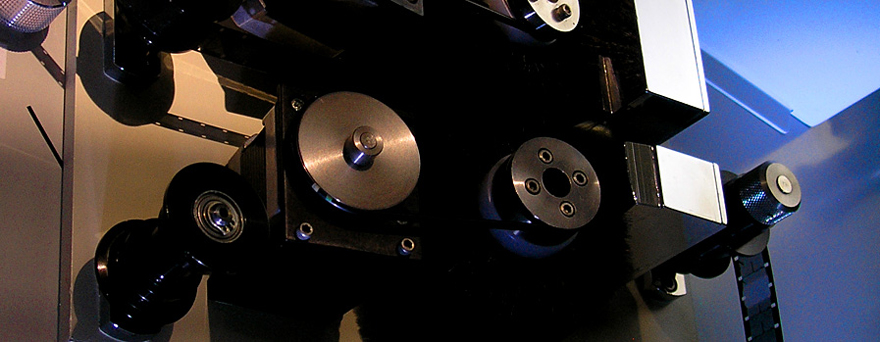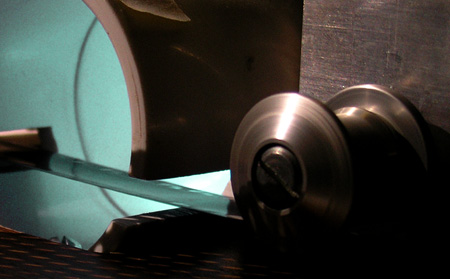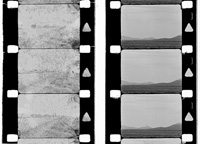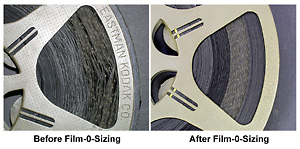|
|
Archival Transfers and Film Restoration Services

Film Preservation: Some basic information to get you started down the right path
Moving image preservation and restoration services for archival
16mm and 35mm movie film has become of increased importance to many in
the field of education, academics, library sciences and documentary
research. Motion picture film collections preserved on the volatile 35mm
nitrate stock that are in danger of further deterioration are prime
candidates for transfer to 10-bit uncompressed digital files while the
image can still be safely recovered. Even very old and somewhat fragile
16mm movie film that has begun to dry out, shrink or crack should be
given serious consideration before recovery becomes near impossible
altogether or a substantial financial hardship for the library,
university or the individual who owns the material.
At the very least those charged with the safe keeping of these
motion picture film elements should do a top to bottom inspection of the
condition of the materials and examine just how they are being stored.
The use of plastic or aluminum reels in place of the old steel type,
which will almost certainly rust over time and leach corrosion into the
film, is an absolute must. The temperature and humidity of the "film
vault" where archived material is stored, if there even is one, should
be closely monitored. A good starting point for achieving proper storage
is to abide by the "40-40 Rule". That means 40 degrees F and 40 percent
humidity for the vault or room that will be used to house the film.
It is a sad fact that whole collections are being disposed of
daily either due to a lack of knowledge or a lack of funding or possibly
both. Our company, TFG Film & Tape, offers a film restoration
service for those films that have reached the critical stage of
deterioration but may still be salvageable using the proprietary
Film-O-Sizing process we have developed.

Our Film Restoration History
Since 1981, TFG has maintained an archival film to video transfer
operation specifically designed to painstakingly and meticulously
convert rare, priceless old 35mm,16mm and 8mm film material to today's
most popular video tape and digital formats. Our expertise has been
called upon to transfer rare or historically significant film footage
for the Wadsworth Atheneum, The Mark Twain House Foundation, Otis
Elevator, The Hartford Insurance, Travelers Insurance, The Connecticut
Historical Society, Pratt & Whitney Aircraft, The Rhode Island
Historical Society, Mystic Seaport, Electric Boat, Connecticut Public
Television, ESPN and countless others. We will gladly examine any film
needing restoration at no cost to the owner and provide an opinion as to
what can and should be done to preserve the images it contains for the
future.
Film-O-Sizing Treatment for Correcting Damaged Movie Film
In some instances, a film reel or portion of a reel may be in
very poor physical condition due to its age or past storage conditions.
It may be degraded to the point of being warped, buckled, shrunken,
twisted or curled well beyond the point it can still be projected much
less converted to another medium. We are able to perform many levels of
film restoration and correction for you using our proprietary
Film-O-Sizing process.

Film-O-Sizing is a gradual,
condition-specific, multi-step process that can clean, condition, correct and restore damaged film.©
The process can be applied to both color and B&W 16mm safety
films and to both originals and prints needing restoration. Films that
were once thought unsalvageable due to the level of decay either
physical or by mold or mildew can, in a great many cases, now be
recovered at least long enough to be converted to a digital format.
Below, are some common examples of film damage before and after being
treated with our Film-O-Sizing restoration process.
Charges for archival film transfer work can vary depending on the
amount and condition of the movie film and the time, equipment and
procedures required to perform the restoration, correction, cleaning,
and conversion. It is very important the client not attempt to unwind a
roll of potentially fragile motion picture film that is suspect as this
can crack the emulsion or brake the film beyond repair. Film that
exhibits a strong vinegar smell or odor may indicate the base layer that
supports the emulsion (picture layer) has begun to deteriorate or
decay. A process of decay known as "vinegar syndrome". A white powdery residue on the outer edges of the film may also
be present as further indication the film is in peril. If you suspect
your film to have condition issues it is best to seek professional help,
first.
 The picture on the left shows a section of original 16mm B&W
film from the 1940's before and after Film-O-Sizing restoration
treatment. When received in our lab the film was extremely
dirty. A fungus was covering the film causing the image to be
almost unviewable. Through an extensive but gentle cleaning the
mold that had attached itself to the film has been safely
and completely removed while leaving the image unharmed and intact.
A successful transfer to a digital file and a very satisfied
client was the end result. If left uncorrected this film would
have deteriorated to the point where saving it would have been
near impossible.
The picture on the left shows a section of original 16mm B&W
film from the 1940's before and after Film-O-Sizing restoration
treatment. When received in our lab the film was extremely
dirty. A fungus was covering the film causing the image to be
almost unviewable. Through an extensive but gentle cleaning the
mold that had attached itself to the film has been safely
and completely removed while leaving the image unharmed and intact.
A successful transfer to a digital file and a very satisfied
client was the end result. If left uncorrected this film would
have deteriorated to the point where saving it would have been
near impossible.
 The
picture on the right shows a typical reel of severely damaged
16mm film from the 1940's. You can clearly see the buckling and
warping in the first picture in this side view of the reel. In
fact the buckling is so bad the film is literally coming off
the the reel. The second image shows how the film appears after
our Film-O-Sizing film restoration process has been applied. The
warping has been corrected and an irreplaceable camera original
film that was once thought destined for the trash now sits
neatly and tightly on the reel ready for transfer. The
picture on the right shows a typical reel of severely damaged
16mm film from the 1940's. You can clearly see the buckling and
warping in the first picture in this side view of the reel. In
fact the buckling is so bad the film is literally coming off
the the reel. The second image shows how the film appears after
our Film-O-Sizing film restoration process has been applied. The
warping has been corrected and an irreplaceable camera original
film that was once thought destined for the trash now sits
neatly and tightly on the reel ready for transfer.
  
Our Film Transfer Facilities
We maintain telecine transfer systems utilizing large-area
imaging tubes as well as digital CCD line arrays, computerized scene by
scene density and color correction, vacuum and/or particle transfer
roller dust collection, electronic grain and random pattern video noise
reduction. Many times the only available existing source of specific
material needed for a documentary are old and worn out 35mm or 16mm film
prints. Our scratch and dirt concealment techniques include chemical,
optical and software technologies that, when combined together as a
three-pronged approach, go a long way towards solving this difficult
problem prior, during and after the digital transfer.

All work is done at our Connecticut USA facility. Your films never
leave our site or our care!
We do not believe in offering any service we cannot perform ourselves in
house. Be assured that if you send your films to us they will remain in
our facility here in Wethersfield, Connecticut for the entire duration
of the process. We do not send customer's precious materials to any
other facility be it in another country or the next town over.
We perform all the work ourselves at our one location.
Cardiology Angiograms | Coronary Angiography | Cine Radiography
Prior to the use of CCD imaging technology for the recording of
angiograms in the practice of cardiology, the procedure of dynamic
angiographic imaging was performed using a high-resolution image
intensifier and a special cineangiographic motion picture camera. The
procedure involves inserting a catheter into the patient's artery and
injecting a radiopaque dye... also called a contrast injection. Commonly
known as cine fluorography, cine angiography, cine fluoroscopy or cine
radiography the entire process was recorded on small rolls of 35mm
panchromatic (B&W) cine film such as Agfa Cinerex PFT, Varicath II
and Vari-X so it could then be studied in greater detail. There are
often situations where these films, usually only a few minutes in
length, need to be converted to a video format or digital file to
provide for a more convenient method of medical examination or, as is
more often the case, for detailed legal analysis.
We can provide this special film transfer service for you.
This web site is Copyright © 2006 - 2019 TFG Film & Tape, All Rights Reserved.
This site or any of its contents may not be copied or mirrored on any other web site or
used in any document, printed or electronic, without the express permission of this site's owner.
If you find certain wording or phraseology used above to explain our work or services on other
web sites please know it has been pilfered from us and is a clear violation of our copyright.
consider having your 16mm film restored before it is too late, if you're located in Hartford, New Haven, Stamford, Norwalk, Waterbury Connecticut or Springfield, Boston Massachosettes, MA, using our film-o-sizing film resizing and restoration process we are able to restore most 16mm film to a transferrable state, by using proper storage techniques movie film will last for many hundreds of years and will outlast digital by some ten fold, film is the archival medium and there is no photographic medium that will last as long as motion picture film, if you have movie film that is brittle or buckling it may be possible to restore it long enough for it to be converted to a digital file or a DVD but you need to act fast, we can restore most 16mm movie film if we get the film in time, 16mm film restoration process for restoring 16mm motion picture film for converting to video DVD by TFG Transfer in Wethersfield Connecticut,
|
|
|
